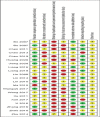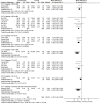Systematic review and meta-analysis of the anti-obesity effect of cupping therapy
- PMID: 37327262
- PMCID: PMC10270516
- DOI: 10.1097/MD.0000000000034039
Systematic review and meta-analysis of the anti-obesity effect of cupping therapy
Abstract
Background: Cupping therapy is a common practice in Korean medicine. Despite developments in this clinical and research area, the current knowledge is insufficient to identify the effects of cupping therapy on obesity. We aimed to assess the effects and safety of cupping therapy on obesity by performing a systematic review and meta-analysis of the effects of cupping therapy.
Methods: A systematic search of databases was conducted, including MEDLINE/PubMed, EMBASE, Cochrane Central Register of Controlled Trials, Chinese National Knowledge Infrastructure, Citation Information by the National Institute of Informatics, KoreaMed, Oriental Medicine Advanced Searching Integrated System, and ScienceON, for full-text randomized controlled trials (RCTs) published through January 14, 2023, with no language restrictions. The experimental groups received cupping therapy combined with traditional Chinese medicine (TCM) and conventional therapy. The control groups received no treatment, conventional therapy, or TCM treatments alone. The experimental and control groups were compared in terms of body weight (BW), body mass index (BMI), hip circumference (HC), waist circumference (WC), waist-hip ratio (WHR), and body fat percentage (BFP). We evaluated the risk of bias using the 7 domains stipulated by the Cochrane Collaboration Group and performed a meta-analysis using Cochrane Collaboration software (Review Manager Software Version 5.3).
Results: A total of 21 RCTs were included in this systematic review and meta-analysis. The analysis revealed improvements in BW (P < .001), BMI (P < .001), HC (P = .03), and WC (P < .001). However, there were no clinically significant changes in WHR (P = .65) or BFP (P = .90), both of which had very low certainty of evidence. No adverse events were reported.
Conclusion: Overall, our results show that cupping therapy can be used to treat obesity in terms of BW, BMI, HC, and WC and is a safe intervention for the treatment of obesity. However, the conclusions of this review should be interpreted with caution in clinical practice because of the uncertain quality of the included studies.
Copyright © 2023 the Author(s). Published by Wolters Kluwer Health, Inc.
Conflict of interest statement
The authors have no conflicts of interest to disclose.
Figures











References
-
- Engin A. The definition and prevalence of obesity and metabolic syndrome. Adv Exp Med Biol. 2017;960:1–17. - PubMed
-
- Blüher M. Obesity: global epidemiology and pathogenesis. Nat Rev Endocrinol. 2019;15:288–98. - PubMed
-
- Seravalle G, Grassi G. Obesity and hypertension. Pharmacol Res. 2017;122:1–7. - PubMed
Publication types
MeSH terms
LinkOut - more resources
Full Text Sources

